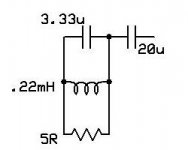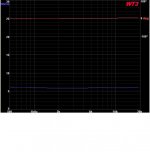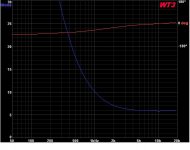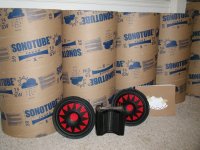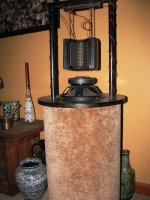Good to hear you are making progress and like the sonics too.
My own impression of "diffraction alignment device" at AMT's is that this combination is capable to push "realism" of AMT reproduction even further.
Michael
My own impression of "diffraction alignment device" at AMT's is that this combination is capable to push "realism" of AMT reproduction even further.
Michael
I notice that the top side of the driver is open.
Could it be that the backwave is causing cancelations at some frequency's? jer
Could it be that the backwave is causing cancelations at some frequency's? jer
It may indeed be causing some, but the vast majority of the front/rearwave interaction will be in no man's land. I've since added a thick felt mat underneath to suppress early reflections from the top of the bass enclosure, so I'm not optimizing for maximum efficiency, shooting more for smoothness of response. I did, however, bevel the edges so I can add a top section if and when I'm ready. These are a fairly unique device and will take some tinkering to really get their best.
New Math
First I have to get the crossover right, before my fidelity improves. When does 8+6=10? In weirdie heil AMT town!
For some reason none of the icons are working for me on uploading images/linking images, or I'd show that I'm not getting impedance summation from a 20uF blocking cap and the amt1, the 6 ohm (very flat) heil and the near-8 ohm cap value (at 1kHz) are summing to... 10.
Good to hear you are making progress and like the sonics too.
My own impression of "diffraction alignment device" at AMT's is that this combination is capable to push "realism" of AMT reproduction even further.
Michael
First I have to get the crossover right, before my fidelity improves. When does 8+6=10? In weirdie heil AMT town!
For some reason none of the icons are working for me on uploading images/linking images, or I'd show that I'm not getting impedance summation from a 20uF blocking cap and the amt1, the 6 ohm (very flat) heil and the near-8 ohm cap value (at 1kHz) are summing to... 10.
First I have to get the crossover right, before my fidelity improves. When does 8+6=10? In weirdie heil AMT town!
For some reason none of the icons are working for me on uploading images/linking images, or I'd show that I'm not getting impedance summation from a 20uF blocking cap and the amt1, the 6 ohm (very flat) heil and the near-8 ohm cap value (at 1kHz) are summing to... 10.
Duh, forest for the trees.... forgot to treat it as a reactive impedance not a resistance.
So, some more shaping and testing- 10uF was too small, (might have worked with the top sections of the horns reinforcing the 1-2k region though, that's more work for later), 20uF works real trick. Then we just have that 5kHz bump to deal with, which is notched out with the .22, 3.33, 5R network. Very smooth response but with a top octave rolloff. Who'd have thunk that heils might need a supertweeter!
But the highpass isn't steep enough yet, I'm looking at possibly overlaying a 3rd/4th order 1k active filter. The shaping/protection cap will remain as I'm not trustin my active system to keep my 35 year old phragms alive.
But the highpass isn't steep enough yet, I'm looking at possibly overlaying a 3rd/4th order 1k active filter. The shaping/protection cap will remain as I'm not trustin my active system to keep my 35 year old phragms alive.
Attachments
So, some more shaping and testing- 10uF was too small, (might have worked with the top sections of the horns reinforcing the 1-2k region though, that's more work for later), 20uF works real trick. Then we just have that 5kHz bump to deal with, which is notched out with the .22, 3.33, 5R network. Very smooth response but with a top octave rolloff. Who'd have thunk that heils might need a supertweeter!
But the highpass isn't steep enough yet, I'm looking at possibly overlaying a 3rd/4th order 1k active filter. The shaping/protection cap will remain as I'm not trustin my active system to keep my 35 year old phragms alive.
Hello Again Badman.
I noticed you're considering 3rd/4th order 1k active filter. After reading that it reminded me of an email I received from Dr. Albert Von Schweikert when I wrote him concerning the large Heil ATM drivers.
Below is a copy of the email I received. Notice the part below in RED as it will be pertinent to what you're considering...
=========================================================
Dear Tom,
I was Dr. Heil’s personal assistant for the last two years of his career and developed the first three-way AMT system, which hit the market just before Oskar died in an auto accident. His wife closed the company, so my design was never sold in large quantities, I believe there were less than 100 units sold in the 3 months it was on the market.
The Heil driver requires a 24dB/octave crossover at 1.2kHz or it will go into distortion.
The Excel magnesium drivers are fantastic and can be crossed over at 1.2kHz with 24dB/oct as well, use a line source of the 6.5” units. I would use an active crossover, a passive crossover would be difficult for you to design unless you had access to test equipment and have extensive experience with circuit design.
Best regards,
Albert Von Schweikert
CEO/Chief Design Engineer
Von Schweikert Audio
Temecula, California , USA
Phone (951) 308-6463
FAX (951) 308-6469
Web: www.vonschweikert.com/
=========================================================
Oh yeah, I'd really like to see a photo of these horns with the tops on when you get a chance..
Thetubeguy1954 (Tom Scata)
Last edited:
Hi Tom:
I'd seen you post this before, thanks. The difference between 1-1.2k is pretty minor, the hornloading helps make the output demands in the lower registers much less for a given on-axis SPL. As far as passive filter design, I'm not sure what he's talking about- these are about the easiest drivers in the world to work with: I've attached an impedance sweep. As you can see, ruler flat, no impedance comp necessary.
When the horns get their "hats" I'll be sure to post it here, with some impressions.
I'd seen you post this before, thanks. The difference between 1-1.2k is pretty minor, the hornloading helps make the output demands in the lower registers much less for a given on-axis SPL. As far as passive filter design, I'm not sure what he's talking about- these are about the easiest drivers in the world to work with: I've attached an impedance sweep. As you can see, ruler flat, no impedance comp necessary.
When the horns get their "hats" I'll be sure to post it here, with some impressions.
Attachments
I can't wait !
But I geuss I'll have to (hehe). jer
Given that this has been an ongoing project for the better part of the year, waiting may serve you well 😉
Maybe I'll find some time this weekend? naaaaa

Couple status updates
You can see the way the top is shaped to allow the use of a flat top panel below:
They're now higher up (better at ear level) and things are much improved with the 7" or so height increase. Hard to know how much of the improvement is due to the height and how much is due to the new bass cab (still deciding on finish options) is hard to say, the cab is certainly improved over the old one (bigger cab, better bracing scheme, better absorption, and the driver is ring-mounted, giving it several layers of damping in the mounting)
You can see the way the top is shaped to allow the use of a flat top panel below:
An externally hosted image should be here but it was not working when we last tested it.
They're now higher up (better at ear level) and things are much improved with the 7" or so height increase. Hard to know how much of the improvement is due to the height and how much is due to the new bass cab (still deciding on finish options) is hard to say, the cab is certainly improved over the old one (bigger cab, better bracing scheme, better absorption, and the driver is ring-mounted, giving it several layers of damping in the mounting)
An externally hosted image should be here but it was not working when we last tested it.
An externally hosted image should be here but it was not working when we last tested it.
Yep, 2226h, but part of the reason I went with the ring-clamping method was to allow easy/rapid driver swaps, I'll be reviewing the Eminence Magnum 15HO and BD BD15 as well. The BD is probably best suited to my purpose but the 2226h is so dynamic and easy to work with.... they magnum wins the looks contest with it's kickin' 4" phase plug.
Hi Badman,
I've been following along with great interest - I also use the AMT1's and enjoy them very much. Buuuuuuut - juz like you - I'm always tempted to do some fooling around with things.
I'm not sure who's construction is more handsome - yours or mine. I'll just say that it's a good thing my wife is supportive of my efforts. 🙄
I've been following along with great interest - I also use the AMT1's and enjoy them very much. Buuuuuuut - juz like you - I'm always tempted to do some fooling around with things.
I'm not sure who's construction is more handsome - yours or mine. I'll just say that it's a good thing my wife is supportive of my efforts. 🙄
Attachments
Hi Badman,
I've been following along with great interest - I also use the AMT1's and enjoy them very much. Buuuuuuut - juz like you - I'm always tempted to do some fooling around with things.
I'm not sure who's construction is more handsome - yours or mine. I'll just say that it's a good thing my wife is supportive of my efforts. 🙄
Very nice sir, you win the cosmetics look for now! I'm eventually going to be making these the centerpiece of an OB 3-way, and the curvy cabs will have to be used for subs or something. I've already built dual 12" M frame dipoles with JBL 123A/2213. Just deciding what to do for a widerange mid, 200Hz-1kHz or so (leaning towards JBL LE8T in a mid-size baffle), and what to do with the crossover (probably actlve/passive hybrid).
The curvy cabs are going to have a cherry veneer (you can't tell well from the pic, but those are 4" roundovers and the whole backside is hemicylendrical) but the driver and vent (or not) mounting boards, on the front side, as well as the driver ring, are up in the air. I'll probably do a solid color, I'm thinking white, to match my beloved white horns.
I forgot to mention - AMT1's are at 34 inch height - used above 6Khz. I'm thinking about taking that down to 3Khz tho.
Also the slight "upward" tilt is no accident - ESS did the same thing to aim the vertical sweet spot for ear height when seated.
Also the slight "upward" tilt is no accident - ESS did the same thing to aim the vertical sweet spot for ear height when seated.
Also the slight "upward" tilt is no accident - ESS did the same thing to aim the vertical sweet spot for ear height when seated.
Yup, my sweeps showed a very narrow vertical dispersion, as expected.
You can see the way the top is shaped to allow the use of a flat top panel below:
An externally hosted image should be here but it was not working when we last tested it.
They're now higher up (better at ear level) and things are much improved with the 7" or so height increase. Hard to know how much of the improvement is due to the height and how much is due to the new bass cab (still deciding on finish options) is hard to say, the cab is certainly improved over the old one (bigger cab, better bracing scheme, better absorption, and the driver is ring-mounted, giving it several layers of damping in the mounting)
An externally hosted image should be here but it was not working when we last tested it.
An externally hosted image should be here but it was not working when we last tested it.
Badman,
I have to commend you on the quality and layout of the internal bracing of your new bass cabinets. I cannot believe that even the insides of these cabinets are nice to look at! My sincerest compliments...
Thetubeguy1954 (Tom Scata)
Badman,
I have to commend you on the quality and layout of the internal bracing of your new bass cabinets. I cannot believe that even the insides of these cabinets are nice to look at! My sincerest compliments...
Thetubeguy1954 (Tom Scata)
Thanks 🙂 I'm very happy with their performance, hard to say how much the sound is better from the cabs vs. from the heils/woofers being at a better height, but whatever, this camper is happy!
The bracing was CNC cut, to allow the use of a clean shelf bracing method inside the complex shaped cab. There is a bottom chamber below the vent (if/when they become vented) which serves as a top-bottom mode killer, that portion is fully stuffed. The top panel is 1.5" thick with holes, with rounded edges, in the inside layer (.75"), as well as some additional bracing/diffusion. There are ribs, with variable spacing, between each shelf brace. A lot of damping is used at the driver/cabinet interfaces as well as the front panel mountings.
- Status
- Not open for further replies.
- Home
- Loudspeakers
- Planars & Exotics
- Hornloading the Heil AMT1
